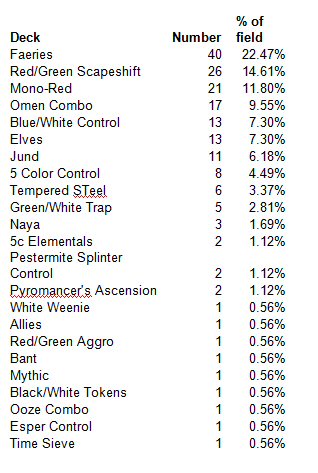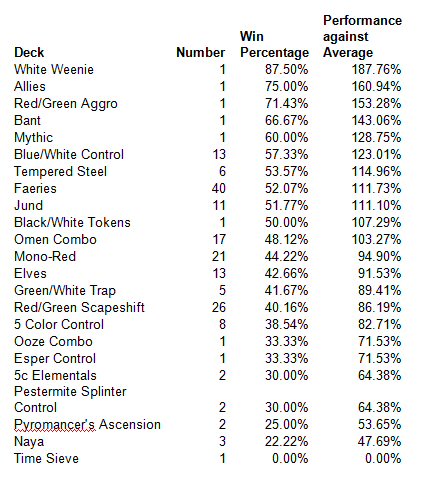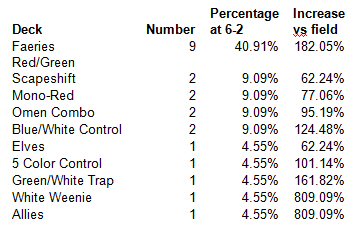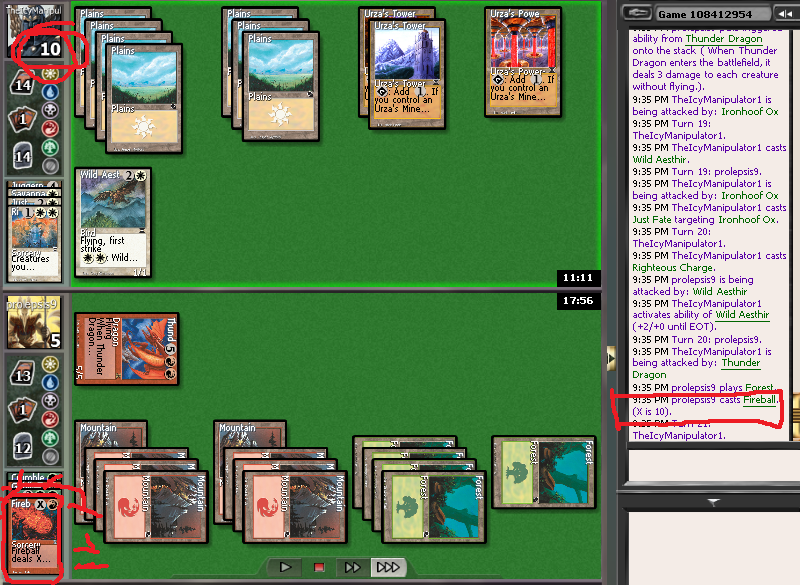One of the idiosyncrasies of Magic Online is that set releases necessarily are necessarily delayed because the public beta can’t happen until the full
spoiler is released. It doesn’t matter whether there’s a plausible workaround that Wizards might use; for now, this delay is a known quantity that we
have to deal with.
So while everyone is busy speculation, brewing and set reviews of how Go for the Throat and Green Sun’s Zenith and Signal Pest will change Constructed,
Magic operates in an alternate reality where Grand Prix: Atlanta isn’t the end of Extended as we know it, but really the launching point for the new
metagame. While sometimes there aren’t any real events happening in this Bizarro universe, the current MODO schedule has PTQs and a Magic Online
Championship Series based on Old Extended.
Two of the big dogs coming out of Atlanta were the builds of Valakut that met in the finals;Jason Ford U/G Scapeshift based on a Gerry Thompson Brew, and Ben Stark’s R/G Scapeshift. Both rely on explosive finishes with
Scapeshift to kill an opponent from any plausible amount of life short of an arbitrarily large value; R/G has the ability to kill an opponent without
Prismatic Omen, using actual Mountains or a Primeval Titan, while the U/G build leverages Preordain and Ponder to find Omen and a permission package of
Mana Leak, Vendilion Clique, and Cryptic Command to make Prismatic Omen a more reliable finish.
While I couldn’t attend Pro Tour: Nagoya even if I were qualified, I have been very invested in figuring out this format due to the Magic Online
Championship Series. My starting decks were R/G Scapeshift, U/W Control, and Faeries. I was a little down on Faeries due to a rise in decks preying on
it, namely Elves and Mono-Red, having been beaten in the eight-man queues repeatedly. I know that both of the matchups were winnable, given a good
sideboarding plan, but it seemed that I was either lacking in identifying the correct lines of play or in executing the approach — so I decided to pick
something else.
With that, I was intent on making R/G work. It had a decent matchup versus Faeries and enough raw power to rein in the other matches. I started with
Stark’s list and my initial goals were to:
1) Shore up the matchups against the decks that were preying on Faeries (they were fast enough to race you if you stumbled or gave them any room)
2) Retool the matchup against Faeries (Great Sable Stag seemed sub-par, considering you probably wanted to push through a game-breaking spell rather
than nug them for three seven times), and:
3) Figure out a plan for the mirror.
The first thing I did was tweak the mana base. I swapped out a Forest for a Khalni Garden, as I found that sometimes I landed a turn 4 Primeval Titan
only to lose on the crackback. Khalni Garden was a fetchable land that could give me some much-needed life points. I also found that I was running out
of Mountains to combo, so I added a eleventh. To find room, I shaved a Forest and a Terramorphic Expanse.
Since I was cheating on green mana, I also got to test some Manamorphoses which the inimitable Phil Samms advocated that gave the deck a little more
reliability, being able to keep the infuriating hands with ramp spells but only red mana.
To deal with Faeries, I replaced the maindeck Lightning Bolts with Volcanic Fallout, and retooled the sideboard to include Guttural Response alongside
Combust. I figured that Fallout would let me survive until I hit seven lands, at which point pushing Scapeshift or Primeval Titan would give me the
win.
To deal with the mirror, I tested Reverberate and Nature’s Claim. Reverberate was great against opposing Scapeshifts (as well as Cryptic Command out of
the blue builds), and Nature’s Claim had great value in any Prismatic Omen-based mirror while also answering a lot of the new hate people were bringing
in against us (even Mindlock Orb — how hateful!).
My last build was this, which I had a lot of success with in the eight-man queues and ten-ticket sit-n-gos (a.k.a. the two-man Gold queues):
Creatures (5)
Lands (13)
Spells (42)
- 4 Forest
- 11 Mountain
- 4 Rampant Growth
- 2 Harrow
- 4 Scapeshift
- 2 Manamorphose
- 3 Prismatic Omen
- 4 Volcanic Fallout
- 4 Khalni Heart Expedition
- 4 Explore
Sideboard

With this, I had a close eye on the last big tournament before MOCS— the MODO Pro Tour Qualifier happening concurrently with the Super Bowl Sunday
night. With a relatively short field, I would be able to load up the data into a spreadsheet for some number crunching. Not to spoil anything — but as
of writing, the semi-finals involve four Faeries decks. While looking at a top 8 can be helpful, I think knowing the starting field can provide some
incredibly valuable data other than OBVOBVOBVFAERIESAFGAIN.
I lovingly copied all the 178 entrants into a Google document and with some help with my fellow travelers from GoodGamery.com, the metagame looked like
this:

As expected, Faeries and various Valakut builds took up a big percentage of the field. Mono Red also had a pretty substantial showing, hoping to prey
on the likely numerous Faeries decks.
When looking at win percentage, however, a new story reveals itself.

(Methodology-wise, it’s a pain the ass exporting data from MODO, so the above is a little fuzzy. I counted actual wins, and derived a win percentage by
assuming people dropped at x-2. Maybe with the new UI we’ll actually be able to copy/paste in chunks and get some real data.)
It’s hard to evaluate the top decks — specifically, the one-offs that got four wins or more (where a little under three was average for the field). The
only copy of White Weenie made the top 8, and I know StarCityGames.com own Reid Duke is an advocate of the deck, so it might be worth a second look.
I don’t have much experience with the deck, but Brave the Elements is one of the strongest cards in the format and it does seem fairly resilient to
multiple angles of attack. Allies managed a 6-2, although it’s an archetype not as well plumbed, so we might be a little bit more skeptical.
R/G Scapeshift underperformed, and none of the Valakut decks made the top 8. U/W Control performed the best of the established archetypes, mirroring
Reid Duke look into the Daily Event metagame.
The new U/W build becoming popular on MODO recently was, I believe brewed by the Brazilians:
Creatures (12)
Planeswalkers (2)
Lands (20)
Spells (26)

The most obvious tech is the maindecked Leyline of Sanctity. While presumably intended to shut out Valakut builds game one, it also has value against
the field, stopping Thoughtseizes, Blightnings, Lightning Bolts and Vendilion Cliques from interfering with your game plan. The deck adopts the
man-plan versus Faeries, going aggro with War Priests of Thune and Coralhelm Commanders.
Spreading Seas also does double duty to answer Valakut and Creeping Tar Pits — two cards that can give U/W fits. Baneslayer and Sun Titan are also
decent answers now that Doom Blade is falling out of favor in Faeries to the versatility of Disfigure, Agony Warp, Smother and Grasp of Darkness (at
least until Go For The Throat hits MODO).
Another metric I looked at was how many decks made 6-2 or better.

We see here again how poorly the Valakut decks fared — only putting 4 in the top 22, a less-than-proportional showing.
Of course, the big story of this PTQ is Faeries. Taking down yet another PTQ is probably nothing new, but there is something intriguing about
how it almost doubled its presence at the top tables despite its overall win percentage being just above average. Compare this to U/W, which increased
its presence in the 6+ win bracket versus the field by 24%, matching its win percentage 23% above mean. This means that for every Faeries player that
dominated late in the field, there were more players who scrubbed out playing the deck.
This suggests that the good Faeries players were very good, whereas the bad ones were not. This lines up with the conventional wisdom that while
Faeries is very strong deck, it requires intimate knowledge of the various lines of play. If you play the deck, play as many games as you can and also
read up on how others play it. Two recent articles I have found incredibly helpful areAri Lax and Sam Black, but it may also be helpful
digging up
Paulo Vitor Damo da Rosa articles from when Faeries was in Standard
.
So what’s next? The data suggest Faeries will continue to be strong for MOCS and the last pre-Mirrodin Besieged Extended PTQ. Normally this would cause
the decks that prey on Faeries to become strong as well — except that I think that those decks aren’t slam-dunk favorites against a competent player,
and as such the balancing presence of U/W will keep them at bay.
U/W also seems like a good choice — but keep in mind that while hitting a top eight might be in reach, escaping out of the single-elimination bracket
is a different matter. If you decide to battle with Baneslayer Angels, I’d advise you to do so only if you are confident you can win out a top
eight that’s half- Faeries. Red might actually still be good, since it’s still a favorable matchup against Faeries, and it’s probably a little easier
dodging U/W on the luck of the draw given that it probably tops out at 10-15% of the field.
With that, the punchline of this article is the anticlimactic “probably Faeries.” Personally, I don’t think I can stick with Valakut, given its poor
performance here. Perhaps its win in Atlanta might not be able replicable due to dedicated sideboard plans in the other decks. The sagacious Jarvis Yu
thinks it might still be good, since it can eke out a 50% win rate against Faeries and has a lot of raw power. I wasn’t that comfortable with the
Faeries matchup, so that narrows it down to U/W and Faeries. I’m going to be mashing both of these decks in the queues this week to narrow it down.
For those of you who want to play at home,
most of the raw data and my chicken scratches are here
.
Bonus section: A Masters Edition 4 Primer
(Apparently, this got lost in the mail and we set it to be published while release events were still going on. It’s still a fun format though, and who
doesn’t want ten shots at opening a dual land?)
Fake formats are like crack to a certain subset of players — and I’m one of them. There’s something about tackling a new format that is refreshing
after the Big Formats start getting stale. While MODO players don’t have proper access to Cube Drafting ( at least not yet), we do have
Master’s Edition drafts, which is an excellent alternative to Scars draft — at least until Mirrodin Besieged comes out.
Master’s Edition 1 was fun despite being a train wreck. Funnily enough, despite the fact that it’s been out for almost three years now, I only recently
learned of an archetype involving Homarid Spawning Bed. I learned about this after fist-pumping to be paired against the guy with Homarid Spawning Bed
in round 5 of a 64-man double shootout draft… only to lose against the guy with Homarid Spawning Bed.
I was actually shocked to see that he had won his first pod with the exact same deck. Turns out that stalling with Illusionary Wall and then making it
into a pile of 1/1s is pretty ok.
Master’s Edition 2 was an actual trainwreck. The creature quality was, on the whole, suspect, so the real bodies often required a lot of
resources to answer. Paired with the lack of true card drawing, it was a really grindy format where most games were about out-attritioning your
opponent. While there was theoretically an aggro deck out there somewhere, your opponents had Wall of Kelp and you had a deck full of Orcish
Conscripts.
Master’s Edition 3 was when they started tending to the Limited environment, and Wizards made it spectacularly fun. The combination of horses and giant
men (Riven Turnbull, rawr!) made for a Timmy-fueled visceral enjoyment as well as interesting drafting and play.
Unfortunately, my MOCS Master’s Edition 4 Sealed pool was pretty awful, so I don’t have much to say about that tournament. I played a lot of better
decks, managing to win some matches by drawing out to a 4-3 record after byes, just missing the top 32. I did play a bunch of Sealeds and Drafts since
then and came to the following observations:
Pack one, pick one, what do you take: Sol Ring or Library of Alexandria?
One of the hallmarks of MED4 is that they had to shove basically every playable card not already printed on MODO into it to complete Classic, short of
the Power 9. This leads to pretty unfair cards like Sol Ring and Library being included, leading to the common situation where you rejoice at a “Swamp,
go” from your opponent (i.e., “Hey, look, I didn’t lose the game on turn 1!”).
Sol Ring gives you a ton of tempo, whereas Library of Alexandria provides card advantage in a format sorely lacking of it. Both are generally
unbeatable when played turn 1.
The practical answer? If you had to choose between the two pack 1 pick 1, take the foil one.
Master’s Edition 4 is a Tempo Format.
Master’s Edition 4 plays very much like a Core Set. The game is primarily decided by bashing mid-range creatures into each other, with a dabbling of
removal and tricks.
Like previous Master’s Editions, however, there are significant gaps in the card pool that change the dynamics of play. For one, there are only a few
opportunities for card advantage. Most of the removal is one-for-one, there are very few tricks, and card drawing is very rare.
From my first glance at the spoiler, it seemed like there was a significant gap between the insane quality guys (Serra Angel, Sengir Vampire, Air
Elemental, Ironhoof Ox) and the average body. Additionally, there are a fair number of cheap, common defensive guys (Brass Man, Dragon Engine, Yotian
Soldier, Giant Tortoise), so that there are a number of creatures that would end up not mattering all that much (like Goblin Bully, Elite Cat Warrior,
and Lim-Dul’s Cohort).
I assumed that it was like MED2 and went into some early drafts with this in mind. I prized quality one-for-one removal, no matter how clunky (Lava
Flow, Just Fate) or conditional (Goblin Firestarter) and played sixteen lands so that I would naturally draw more spells, despite the fact that mana
costs are on average more expensive.
I had games where I played some dudes and drew more spells — but mostly, I lost a lot. I had decks full of cards that were “good,” removal and utility
cards and only creatures that mattered, except I was losing to those Goblin Bullys and Elite Cat Warriors that I originally thought were irrelevant.
The problem is MED4 is very much a tempo format. It is very unlike MED2 — because despite the availability of defensive creatures, there are also
enough quality aggressive creatures to deal with them. It is relatively easy to attack through a Yotian Soldier, whereas attacking through an Icatian
Phalanx and any other warm body usually involved collecting damage and power from three or four cards.
While quality removal and efficient bodies should be prized, you have to tend to your creature curve. The two- and three-drops in MED4 are definitely
in danger of getting outclassed quickly by the more powerful four- and five-drops, but they are also necessary inclusions in almost all decks. Aggro
decks can take advantage of any stumble on their opponent’s part. Control decks need them to prevent from getting run over before they can play their
trumps. The format is not so slow that you can afford only to use removal on creatures that “matter,” so matching early creatures with early creatures
can maximize its value.
With this in mind, creatures like Giant Tortoise, Alaborn Musketeer, and Argothian Pixies become very important, since they are quality creatures that
fill the shallower portions of your curve.
This also puts a lot of pressure on your mana base. Missing drops can put you significantly far behind and there are few ways to make up lost ground. I
am pretty leery on splashing for anything short of cream of the crop removal, and would say seventeen lands is pretty much the minimum.
No matter what you think it does, read it again.
I have fist-pumped when my opponent declared blockers and then tapped 2W for Just Fate. I have lost a game because I thought Detonate was an instant
(no, I wasn’t playing during Mirrodin).
Artifact removal is bad, Artifacts are bad.
Despite the artifact theme and how good certain pieces of removal are (Divine Offering omg), artifact removal has to be pretty good before you should
run it. Most decks will have a fair number of artifacts and a bunch of quality targets, but this isn’t Scars block; it’ll be rare to come across
someone with more than seven artifacts. Your removal will already be conditional enough that you will need the effect to be especially splashy when it
is online.
Divine Offering is the perfect card.
Instant speed, gains tempo, usually gains a ton of life so it even helps you win a race. I always sign in relief when my first artifact doesn’t get
Offeringed. I also really like Scavenger Folk, since it’s an early drop that can do other things (including trading with a 2/1) before you need to do
Shatter duty.
A quick Divine Offering story: I’m pinging away at my opponent with some dudes through his Living Wall. I Fireball him post-combat for exactsies and he
Divine Offering his Living Wall and regenerates it to stay at four life.
The next turn, I swing with my 3/3, 3/4, and 2/1. He blocks, regenerates his Living Wall and casts a second Divine Offering to go to eight…
and then immediately dies. (I was baffled, until I realized he had accidentally blocked my trampling War Mammoth instead of my Southern Elephant.)
Similarly, I despise Crumble.
While you’re almost always hitting something that costs more, the lifegain can actually put your opponent ahead on tempo. Save it and Artifact Blast to
bring in against heavy artifact decks. Dust to Dust and Primitive Justice can be excellent, but there are very few times where you’re actually able to
get full value out of them. Justice obviously is very good since it can play Shatter, but don’t evaluate it as if it did more than that on a consistent
basis. If your opponent plays Ebony Rhino on an empty board, are you going to wait for her to play another artifact?
Of course, you still play artifact removal and your opponent likewise will play what he picks. Understand that you play artifacts only because you have
to. If you need another three-mana flier, play Aesthir Glider. If you need a big piece of fat, play Obsianus Golem. Besides Mishra’s Workshop and
colored mana concerns, however, there aren’t actually any benefits to running artifacts. If you had something else as good, you would play that
instead.
The first artifact you run in your deck brings a significant cost. Why?
Because tcard will turn on whatever artifact removal your opponent is playing. Red and green in particular have consistent power, so you can play very
few artifacts, but the same can be said of any color.
If this is the case, it may be worth cutting a normally solid card like Primal Clay for something with less raw power if it means you will now blank a
number of cards in your opponent’s deck. Some decks will have so many artifacts that this effect doesn’t matter, but it’s definitely something to keep
in mind in a deck with one or two artifacts.
Losing the unloseable game.
Similar to the devastating mass removal, there are some pretty brutal hosers that can shut off entire lines of attack. If you are playing Forests or
Islands, sandbag some lands to hedge against Acid Rain or Tsunami. Mountains are out of luck, having no outs to Conversion, but for some reason Swamps
got out easy with no Karma in the set. Al-abara’s Carpet has the potential to lock out some decks, though it’s a little more narrow and fragile.
In the Magic Online Championship, we got the privilege of playing MED4 draft a whole month before it went into wide release. I was watching Logan
Nettles’ (Jaberwocki) R/G deck beat down Akira Asahara’s Mono-White deck. Logan had a pretty good start with some goblins, and Akira was on the back
foot. Akira had a Wild Griffin and a Conversion, though Logan had some big creatures with a Bee Sting and Primal Clay in hand. Akira played Island
Sanctuary and started skipping his draw step with two cards in hand. Logan played his Primal Clay as a 2/2 flier and Akira immediately Divine
Offeringed it. Logan cast Bee Sting, and Akira’s last card in hand was Healing Salve. All the rest of Logan’s removal required red mana. With zero
cards in hand and outnumbered five creatures to one, Akira had Logan in a hard lock.
This problem is exacerbated with the fact that there is literally no enchantment removal in the set. I can count exactly two ways of getting an Island
Sanctuary into a graveyard from play and neither of those ways works if they’re on your opponent’s side. C’est la vie.
A public service announcement: Fireball can be cast with zero targets.

